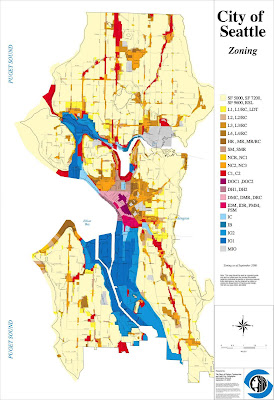Townhouse developments and other DPD stuff
A Stranger SLOG post deals at length with a concern raised by architect (and former Central Area resident and Central Neighborhood Association chair) David Foster:Large developments in Seattle are supposed to be reviewed under the State Environmental Policy Act (SEPA), which triggers a design review by the city. This ensures the finished devlopment fits with the neighborhood and doesn’t kill fish. However, some developers have found a way around that process called “piecemealing”: By applying for separate building permits for smaller adjacent properties, developers can build major projects but only submit to the scrutiny of a simple construction, like building a house.
You'll have noticed that many of the DPD (Dept. of Planning and Development) notices I circulate mention such "unrelated" adjacent developments in passing. The Slog post (and Foster's letter to the West Seattle blog) explain it much better than I can. Council Chair Conlin replied to the West Seattle blog: most commenters were not convinced.
Much of this DPD stuff I point out to you is dry, dull and complicated, and seems unlikely to affect our daily lives (unlike a deranged man with a knife). However, in our rapidly developing part of the City, many of the changes that are being proposed (see next post) or being tacitly allowed, will make profound differences to our neighborhood, and may well take it in directions we don't really want.
Comments on the SLOG item hit up the main points, but some bear repeating here:
- Townhouses are everywhere now, in part because construction insurance for condominiums is so expensive: condominium owners' associations have deep pockets and sue builders about leaking siding, individual townhouse owners don't.
- There's also more profit in townhouses and (to be honest) many people probably prefer not have strangers above and below them. We'll see if they still favor all those stairs when they're 75.
- The City is trying to cram lots of new developments into the multi-family zones in Seattle, to comply with the Growth Management Act. They'd probably prefer the even higher densities of condominiums/apartments, but don't seem to be able to stem the flood of townhouses.
- The garages in townhouses are so small, and hard to access, that even tiny cars finish up on the streets. (Slog comment #5 and #15 ). Some people (and the City) keep trying to insist that we don't need cars as we can get to work by bus/bike/etc, and that the garages should be eliminated (at least in Urban Centers). I do walk/bike to work but I still want a car! Why? Because I (unlike the City) see myself as more than just a worker: I want to enjoy the uncrowded and scenic NW outdoors (that the Growth Management Act seeks to preserve), and you really can't do that without your own old clunker - think Flexcar wants you to put chains or bikeracks on their cars and take them down potholed dirt roads to deserted trailheads to be broken in to? (See Central District News thoughts on this).
- Seattle is trying to accommodate a LOT of new residents, and is putting all that new growth in the exisiting multifamily zones and neighborhood commercial areas: multistory apartments/condos and townhomes. However, as the DPD map above shows (click for a readable version), most of the City is zoned for single family residences (the ~ 75% that's light tan: SF zones) but all the development is going in the multifamily (L1 to L4, NC 1 to NC3) areas. The SF zone residents have fiercely opposed any attempt to increase housing density in their areas (mother-in-law units, etc).

1 comment:
Thanks for the link. This originated on our site (after publishing David Foster's letter, we flagged Slog since we know they care about development issues too, while other citywide media operations are hit-miss on such issues at best). Worth noting that we have also posted a followup; the first city official to whom we sent the original link is Council President Richard Conlin, who had been in West Seattle just a week earlier making some intriguing comments about development and zoning (at the Alki Community Council meeting). The followup with his reply is here. Picking up on a commenter's suggestion, tomorrow we will be publishing a compilation of West Seattle townhouse-project photos, for those who wanted to see them side-by-side.
Post a Comment